Nobu’s Miso Marinated Black Cod Recipe is very similar to the Saikyo Yaki Miso Marinade and Saikyo Yaki Fish recipes that I posted some time ago. Nobu’s marinade is a Westernised version with a stronger flavour – particularly the sweetness.
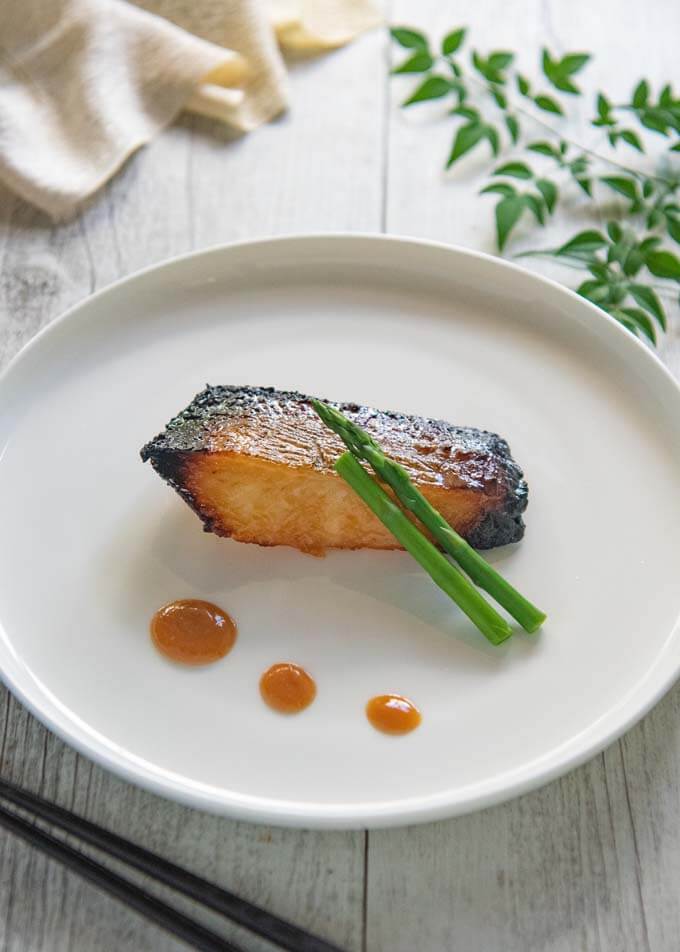
I posted this recipe a few months ago. But, I needed to re-publish this post with new photos because my son commented that the first photo (hero shot) was not great due to the shape of the fish.
I must admit that I was not 100% happy with the shape of the fillet either, but at the time, I could not find the better shape of the fish fillets. So, here is the updated version with new photos. In addition to the change of the photos, I added a video. The rest of the post including the recipe has not changed.
Nobu called this miso marinade ‘Nobu-style Saikyo Miso’ and it is a bit different from the traditional Saikyo miso. It is great to be able to experience this dish from Nobu, the world-famous Japanese celebrity chef.
Nobu-style Saikyo Miso marinade vs Traditional Saikyo Miso marinade
The traditional Saikyo miso is quite pale in colour, almost beige colour, and has a mild sweetness that comes from the sugar and the reduced amount of salt added to the miso. The Saikyo miso paste has a much softer texture, unlike other types of miso
As you can see in my recipe Saikyo Yaki Miso Marinade, I added only a small amount of sake, mirin, and sugar to make the traditional Saikyo miso marinade.
Nobu uses normal shiro miso (white miso) instead of Saikyo miso to make his marinade. I call it normal shiro miso because Saikyo miso is also shiro miso. You can learn more about different types of miso in my post Pantry Essentials for Japanese Home Cooking – Part 1.
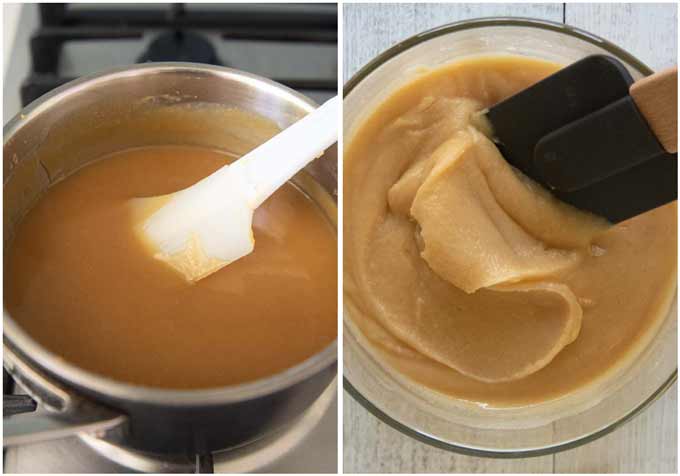
Left: Nob-style Saikyo miso. right: Traditional Saikyo miso.
Normal shiro miso is a light brown colour and contains more salt than Saikyo miso. To compensate for the strong saltiness, Nobu adds quite a lot of sugar to the miso. He also adds a large quantity of sake and mirin so that the marinade becomes a similar consistency to the traditional marinade.
Glacier 51 Toothfish and Black Cod/Sablefish
Nobu’s Saikyo Yaki is made with black cod fillets. I think black cod is the best fish to make Saikyo Yaki with.
Black cod (also called sablefish) is a deep-sea fish that can be caught in the North Pacific Ocean. The flesh is white and soft. When cooked, the meat has a flaky texture like cod and a high fat content that makes it super tasty.
Black cod does not belong to the cod species. It gained the name ‘black cod’ because the flaky texture of the cooked meat is similar to cod and the colour of the skin is almost black.
Unlike Japan unfortunately, it is very difficult to buy black cod in Australia, at least for common consumers.
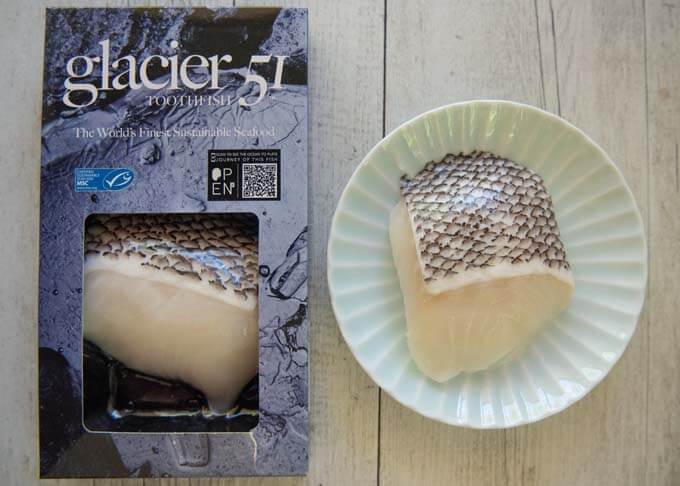
Glacier 51 Toothfish fillets. They come in different shapes.
So, I substituted black cod with Glacier 51 toothfish (also known as Patagonian toothfish/Chilean sea bass, see the photo above), which has a very similar texture and fat content to black cod. Some say that Glacier 51 toothfish is as good as, or even better than, black cod.
Patagonian toothfish is also a deep-sea fish that lives in the cold sea. Glacier 51 toothfish is the species that lives in the icy waters of the sub-Antarctic, under the large glacier called Fiftyone Glacier on Heard Island.
You can only buy Glacier 51 toothfish frozen in Australia, and it is a bit expensive. But for a special occasion, I think that Glacier 51 toothfish Saikyo Yaki is totally worth it.
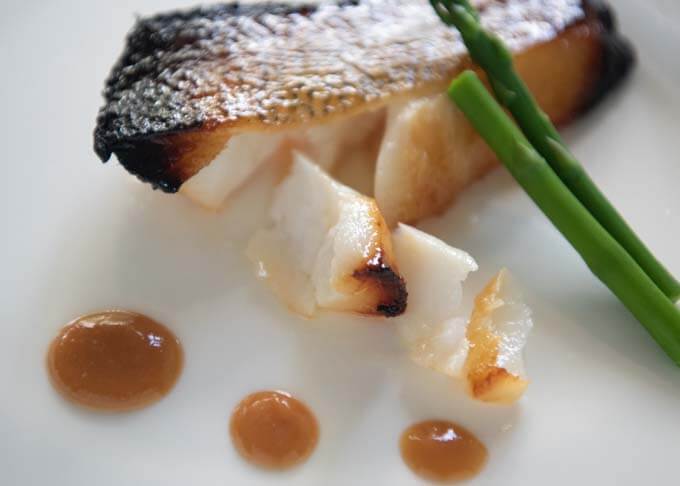
What’s in Nobu’s Miso Marinated Black Cod
This is the recipe straight from Nobu’s cookbook called The Cookbook, with the portion adjusted accordingly. But I used Glacier 51 toothfish fillets instead of black cod fillets.
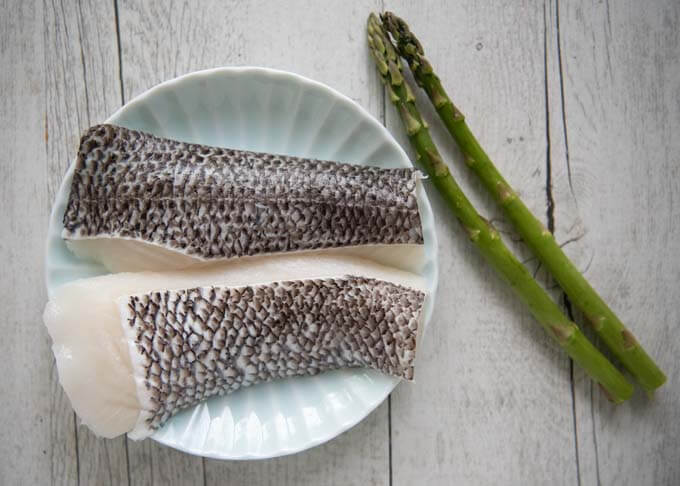
- 2 x Glacier 51 toothfish fillets, thawed in the fridge
- 2 spears of blanched asparagus for garnish
Nobu-style Saikyo Miso
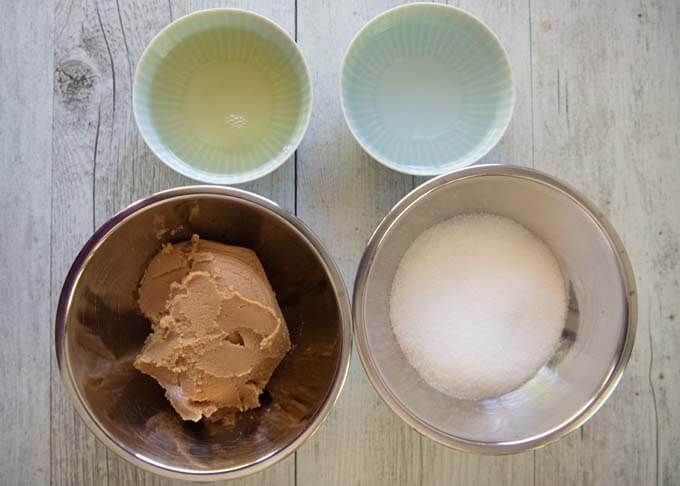
- Shiro miso (not Saikyo miso)
- Cooking sake
- Mirin
- Sugar
You need to use normal shiro miso, not sweet shiro miso such as Saikyo miso because Nobu’s recipe uses quite a lot of sugar to make the marinade sweet. The photo below is a comparison between shiro miso and sweet shiro miso/Saikyo miso.
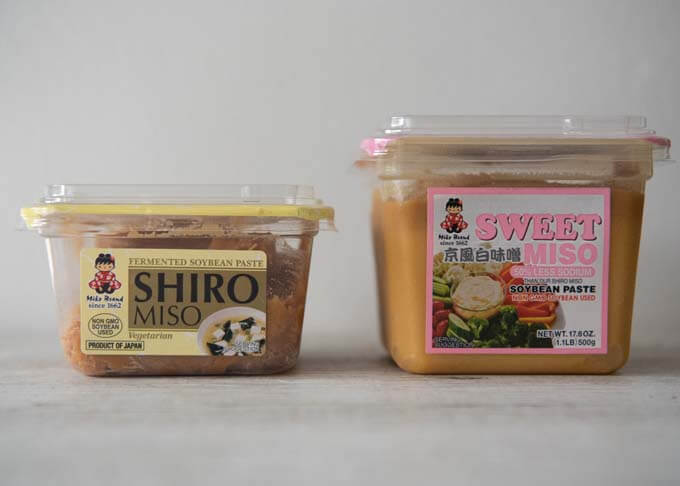
My toothfish fillets were 150g/5.3oz each. If you can buy black cod fillets, please use black cod by all means. Although Glacier 51 toothfish and black cod are great to make Saikyo yaki, you can use other kinds of fish as per my Saikyo Yaki Fish recipe.
When I made Glacier 51 toothfish Saikyo Yaki for a dozen people at my Yakitori party, I halved each fillet and served a thinner piece per person so that I could bring the cost down. Each serving was only 75g/2.6oz, but it was not too small at all by Japanese standards. I thought the portion was just right with the strong sweet miso flavour.
How to Make Nobu’s Miso Marinated Black Cod
Unlike my Saikyo Yaki Miso Marinade, you need to use a stove for a short while to make Nobu’s Miso Marinade. See the video.
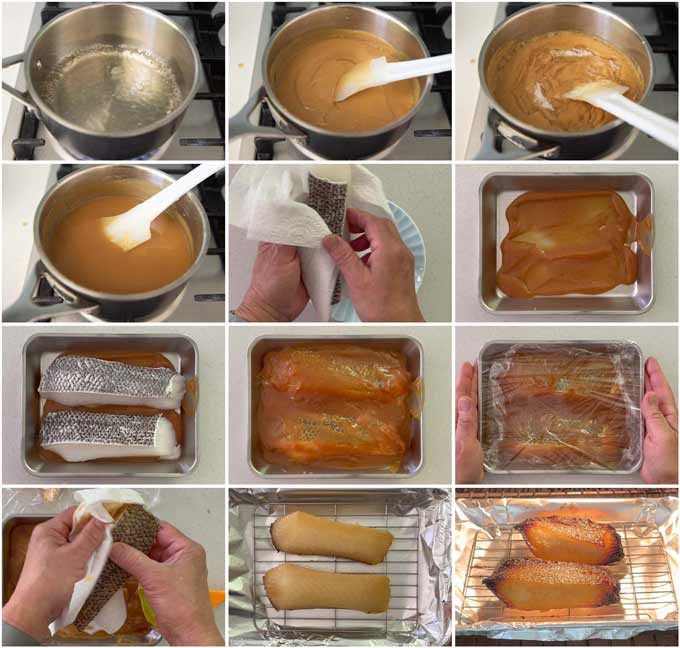
- Put sake and mirin in a saucepan and boil for 20 seconds to remove alcohol.
- Add miso to the pan and dissolve.
- Add sugar to the pan and dissolve. Cool it down.
- Marinate fillets in the Miso marinade and leave it in the fridge for 2-3 days.
- Wipe the marinade off the fish fillets and grill.
Nobu’s recipe suggests adding a few extra drops of marinade on each serving plate after plating the fish, which makes the dish look professional. If you want to do this, you’ll have to reserve a small amount of the marinade before marinating the fish.
At my yakitori party, I made today’s dish (Nobu’s Saikyo Yaki Fish) as well as my version of Saikyo Yaki Fish so that people could compare the flavours. Some people liked Nobu’s version, and others preferred my version.
I think that people who are used to strong flavours prefer Nobu’s and people who like a lighter flavour (like me), enjoy my Saikyo Yaki.
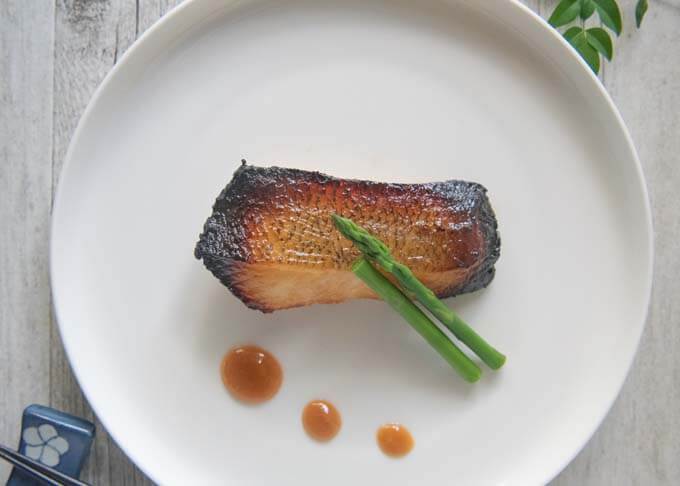
You’ll have to make both versions of Saikyo Yaki to decide which flavour you like better!
Note: I decided not to include the section Meal Ideas today. If you visit my post, Saikyo Yaki Fish, you will see what sort of dishes might go well with Saikyo Yaki.
Yumiko![]()
Watch How To Make It
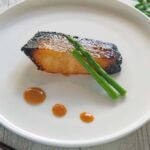
Nobu's Miso Marinated Black Cod Recipe is very similar to the Saikyo Yaki Miso Marinade and Saikyo Yaki recipes that I posted some time ago. Nobu’s marinade is a Westernised version with a stronger flavour, particularly the sweetness. See the video.
This is a recipe from his cookbook called The Cookbook. I only changed the fish fillet to be marinated. Instead of black cod fillets, I used Glacier 51 toothfish fillets.
There isn't Meal Ideas today. If you visit my post, Saikyo Yaki Fish, you will see what sort of dishes might go well with Saikyo Yaki.
- 2 fillets Glacier 51 toothfish thawed in the fridge (150g/5.3oz each, note 1)
- 50ml/1.7fl.oz cooking sake
- 50ml/1.7fl.oz mirin
- 150g/5.3oz shiro miso (note 2)
- 75g/2.6oz sugar
- 2 spears asparagus blanched and cut into half lengths (note 3)
-
Put sake and mirin in a saucepan and bring it to a boil over high heat. Boil for 20 seconds to let alcohol evaporate.
-
Reduce heat to low and add miso to the pan. Mix well until the miso dissolves completely with no lumps.
-
Turn the heat up to high and add sugar. Mix well until the sugar dissolves, then turn the heat off.
-
Let it cool to room temperature.
-
Pat-dry the fish fillets with kitchen paper.
-
Slather slightly less than half of the miso marinade into an air-tight container, or a tray that can just fit in the fish fillets without overlapping (note 4).
-
Place the fish fillets on the miso, without overlapping, then slather the surface of the fillets with the rest of the marinade. Ensure that the fish fillets are coated in the miso marinade completely (note 4).
-
Cover the surface of the marinated fish with a piece of cling wrap, pressing down the cling wrap so that there are no air pockets between the surface of the marinated fish and the cling wrap.
-
Cover the tray with another piece of cling wrap and leave it in the fridge for 2-3 days.
-
Preheat the grill or a broiler.
-
Wipe the marinade off the fish fillets (note 5).
-
Place the fillets on the grill/broiler (note 6) and cook for about 5 minutes (note 7).
-
Turn the fillets over and cook for further 5 minutes (note 6) until the edges of the fillets turn slightly charred.
-
Place each grilled fillet on a serving plate, then place two asparagus sticks leaning against the fish.
1. Nobu’s recipe uses black cod fillets, but I cannot buy them in Sydney. So, I substituted them with Glacier 51 toothfish fillets, which are considered to be equally tasty and fatty.
Glacier 51 toothfish comes frozen and the fillet I bought was 150g/5.3oz per pack. See the photo in the post.
Instead of black cod or Glacier 51 toothfish, which are not cheap, you can marinate salmon, Spanish mackerel, etc.
2. Standard shiro miso is not the same as Saikyo miso, which is sometimes labelled as sweet shiro miso (see the photo in the post comparing standard shiro miso and sweet shiro miso). Also, the colour of shiro miso is not necessarily pale beige. It is often light brown like the miso I used.
3. Nobu’s recipe used pickled ginger sprouts as garnish, but these are very difficult to find in Australia. So, I used blanched asparagus spears to add a colour to the dish. You can also use the other garnishes that I showed you in my Saikyo Yaki Fish recipe.
4. Nobu’s recipe simply says that you slather the fish with miso marinade and place in a dish or a bowl. But I found that slathering the fillets in your hand is quite messy, so I did it my way. It doesn't matter how you coat the fish fillets with the miso marinade.
5. It’s OK to have some miso marinade left on the fish. Do not rinse it off.
6. The distance between the heat and the fish should not be too close because the surface of the fish burns before the fish is cooked halfway. The distance should be about 10cm/4".
7. The cooking duration varies depending on the thickness of the fillet. My fillet was about 4cm/1½½" thick.
8. Nutrition per serving. The amount of marinade consumed should be minimal but for the calculation purposes, it is assumed that 20% of miso marinade is consumed.
serving: 263g calories: 375kcal fat: 3g (5%) saturated fat: 1g (5%) trans fat: 0.0g polyunsaturated fat: 0.8g monounsaturated fat: 0.8g cholesterol: 75mg (25%) sodium: 359mg (15%) potassium: 488mg (14%) carbohydrates: 35g (12%) dietary fibre: 0.4g (2%) sugar: 30g protein: 31g vitamin a: 0.1% vitamin c: 0% calcium: 1.8% iron: 6.2%
Originally published in November 202, updated in January 2023 with better photos and a video added. No changes to the recipe.
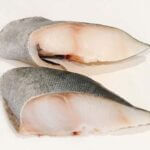
Hi Yumiko. I love blackened cod. Thank you for sharing this recipe. I’m going to try it. If I use the oven, I assume that it is the grill function (grilling at the top shelf) to be used (rather than the normal baking function at the lower shelf). Please advise what temperature should the oven be preheated to grill the cod?
Hi Eliza, yes, it is the grill function at the top shelf. Pre-heat it to 230-250°C/446-482°F.
For cooking i steam for a par cook then grill to finish fish stays very moist
Hi Craig, that’s a great idea. Thanks for the suggestion!
I made this with Glacier 51 Toothfish and it was delicious. The method was easier than other miso baked recipes I’ve done. Thanks!
Hi Jane, that’s great. Glacier 51 Toothfish is one of the best fish for miso marinade!
Yumiko, Thank you for sharing the lovely recipe. I made it and it was a great success. I want to bring your attention to using Glacier 51 tooth fish. You may not be aware of this but it’s an endangered species. The original name is Patagonia tooth fish and then it was given the name Chilean sea bass to make it more palatable. It’s a wonderful fish to cook with and it was widely embraced but this great creature which lives for many decades was quickly overfished in the last couple decades and now has become endangered. I encourage you to adapt your recipe and use halibut or some other fish that is available in Australia.
Hi Angelina, thanks for the note. My understanding is that the quota of Glacier 51 is controlled by the authorities and that’s why restaurants started serving glacier 51 in recent years. As I indicated in the post, Glacier 51 was used as an alternative to black cod to mimic Nobu’s restaurant dish. I also mentioned that you could marinade other kind of fish referring to my Saikyo Yaki recipe. so, hopefully, people do use Glacier 51 only on a very special occassion.
Charming recipe, thanks! Thank you for pointing this out, Angela, yes, the “Chilean Sea Bass” (what it’s called in our part of the world) is as endangered and overfished as it is delicious. I’ve been avoiding it for this reason since about 2000. Plenty of other tasty fish that aren’t fished out…not to mention Tofu, which also tastes great via this recipe!
Thank you, Jake. I agree with you that we should use other fish. Besides, Chilean Sea Bass is too expensive!
The ultimate choice in sustainability, Glacier 51 Toothfish has been certified sustainable by the Marina Stewardship Council (MSC).
Hi Charles, thanks for the information. As long as the quota is well controlled, consumers should be able to enjoy beautiful fish like Glacier 51 Toothfish.
Hi Yumiko, can we reuse the miso marinate? Im just thinking it be a waste to throw away. Thabkyou
Hi Taylor, you can reuse the marinade once or twice, but no more than twice. Instead of fish, you can marinate meat if you like.
Thankyou for your reply, is it possible to use it as a soup miso? I shall try. Regards
Hi Tay, it will be very sweet for a miso soup. You may need to add saltiness to it. You can also use the miso to cook fish fillet in it, like my recipe, Simmered Mackerel in Miso. You may need to adjust the flavour if you find it too sweet.
Please DO NOT re-use marinade unless you cook it! Marinade could grow bacteria etc. and could potentially make you VERY ill. Never re-use or serve a marinade used on raw proteins without bringing it to a boil. I work in food and food safety.
Hi Laurie, you are right. I should have explained it in more detail. It can be reused but the miso marinade needs to be reheated. The process is to bring the used miso marinade to a boil until the excess liquid is evaporated.
Hi Tay, Laurie reminded me that you should not reuse the marinade used for raw fish without bringing it to a boil. I should have added the following:
It can be reused but the miso marinade needs to be reheated. The process is to bring the used miso marinade to a boil until the excess liquid is evaporated. You may want to check the flavour to see of it became thinner than the first marinade. If so, add a small amount of miso.
Omg, I had this dish at Nobu KL and it was sooo lovely, now I have the recipe, yea!
Met Nagi at Chermside last Friday, you must be so proud of her.
Thanks Yumiko
Hi Barb, you will find that it’s quite easy to make such a delicious food. Enjoy!
I’m looking forward to trying this, I have some sea mullet which is oily. For once I have all the ingredients!
Hi Irna, that’s great. Please let me know what you think.
I love love reading your before getting to make your dish I know I’ve said it many times before. I find your blog so educational on ingredients in particular. I clicked on the link to read about the salmon recipe you spoke about. I just sorry I won’t be able to try them anytime soon, only got out of hospital this afternoon and unable to eat or drink anything hot for awhile. Had to have all my teeth removed the worst thing ever to happen to a foodie who love food texture and crunch… but have some delicious looking Yumiko fish dishes to try…💜💐
Hi Lidi, I am sorry to hear about your teeth. I hope you can enjoy food soon.
OMG, Lindi, I’m so sorry!! Please read about Grant Achatz for inspiration